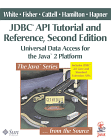JDBCTM was designed to keep simple things simple. This means that the JDBC API makes everyday database tasks, like simple
This chapter has not yet been updated to reflect features and conventions of the latest release, JDK 6.0.
SELECT
statements, very easy. This trail will walk you through examples of using JDBC to execute common SQL statements, letting you see for yourself how easy it is to use the basic JDBC API.
![]() JDBC Basics
covers the JDBC 1.0 API, which is included in JDK
tm
1.1. The second part covers the JDBC 2.0 API, which is part of the JDK 1.2 release. It also briefly describes the JDBC extension API, which, like other standard extensions, will be released independently.
JDBC Basics
covers the JDBC 1.0 API, which is included in JDK
tm
1.1. The second part covers the JDBC 2.0 API, which is part of the JDK 1.2 release. It also briefly describes the JDBC extension API, which, like other standard extensions, will be released independently.
By the end of this lesson, you will know how to use the basic JDBC API to create tables, insert values into them, query the tables, retrieve the results of the queries, and update the tables. In this process, you will learn how to use simple statements and prepared statements, and you will see an example of a stored procedure. You will also learn how to perform transactions and how to catch exceptions and warnings. In the last part of this lesson, you will see a how to create an applet.
Note:
Available now from amazon.com The material on the JDBC 1.0 API is excerpted from the first edition of JDBC Database Access with Java: A Tutorial and Annotated Reference, published by Addison Wesley Longman, Inc., and written by Graham Hamilton, Rick Cattell, and Maydene Fisher. For more complete information about the JDBC 2.0 API and the JDBC extension API, see the second edition, JDBCTM API Tutorial and Reference, Second Edition: Universal Data Access for the Java 2 Platform written by Seth White, Maydene Fisher, Graham Hamilton, Rick Catell, and Mark Hapner. Published by Addison Wesley Longman, Inc. June 1999.
